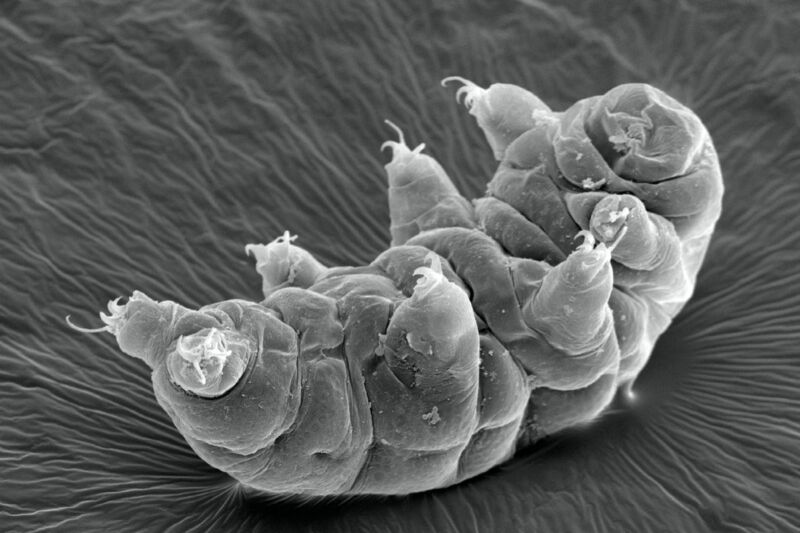
Cultura RM Exclusive/Gregory S. Paulson/Getty Images
Since the 1960s, scientists have known that the tiny tardigrade can withstand very intense radiation blasts 1,000 times stronger than what most other animals could endure. According to a new paper published in the journal Current Biology, it’s not that such ionizing radiation doesn’t damage tardigrades’ DNA; rather, the tardigrades are able to rapidly repair any such damage. The findings complement those of a separate study published in January that also explored tardigrades’ response to radiation.
“These animals are mounting an incredible response to radiation, and that seems to be a secret to their extreme survival abilities,” said co-author Courtney Clark-Hachtel, who was a postdoc in Bob Goldstein’s lab at the University of North Carolina at Chapel Hill, which has been conducting research into tardigrades for 25 years. “What we are learning about how tardigrades overcome radiation stress can lead to new ideas about how we might try to protect other animals and microorganisms from damaging radiation.”
As reported previously, tardigrades are micro-animals that can survive in the harshest conditions: extreme pressure, extreme temperature, radiation, dehydration, starvation—even exposure to the vacuum of outer space. The creatures were first described by German zoologist Johann Goeze in 1773. They were dubbed tardigrada (“slow steppers” or “slow walkers”) four years later by Lazzaro Spallanzani, an Italian biologist. That’s because tardigrades tend to lumber along like a bear. Since they can survive almost anywhere, they can be found in lots of places: deep-sea trenches, salt and freshwater sediments, tropical rain forests, the Antarctic, mud volcanoes, sand dunes, beaches, and lichen and moss. (Another name for them is “moss piglets.”)
When their moist habitat dries up, however, tardigrades go into a state known as “tun”—a kind of suspended animation, which the animals can remain in for as long as 10 years. When water begins to flow again, water bears absorb it to rehydrate and return to life. They’re not technically members of the extremophile class of organisms since they don’t so much thrive in extreme conditions as endure; technically, they belong to the class of extremotolerant organisms. But their hardiness makes tardigrades a favorite research subject for scientists.
For instance, a 2017 study demonstrated that tardigrades use a special kind of disordered protein to literally suspend their cells in a glass-like matrix that prevents damage. The researchers dubbed this a “tardigrade-specific intrinsically disordered protein” (TDP). In other words, the cells become vitrified. The more TDP genes a tardigrade species has, the more quickly and efficiently it goes into the tun state.
In 2021, another team of Japanese scientists called this “vitrification” hypothesis into question, citing experimental data suggesting that the 2017 findings could be attributed to water retention of the proteins. The following year, researchers at the University of Tokyo identified the mechanism to explain how tardigrades can survive extreme dehydration: cytoplasmic-abundant heat soluble (CAHS) proteins that form a protective gel-like network of filaments to protect dried-out cells. When the tardigrade rehydrates, the filaments gradually recede, ensuring that the cell isn’t stressed or damaged as it regains water.
When it comes to withstanding ionizing radiation, a 2016 study identified a DNA damage suppressor protein dubbed “Dsup” that seemed to shield tardigrade genes implanted into human cells from radiation damage. However, according to Clark-Hatchel et al., it still wasn’t clear whether this kind of protective mechanism was sufficient to fully account for tardigrades’ ability to withstand extreme radiation. Other species of tardigrade seem to lack Dsup proteins, yet still have the same high radiation tolerance, which suggests there could be other factors at play.
A team of French researchers at the French National Museum of Natural History in Paris ran a series of experiments in which they zapped water bear specimens with powerful gamma rays that would be lethal to humans. They published their results earlier this year in the journal eLife. The French team found that gamma rays did actually damage the tardigrade DNA, much like they would damage human cells. Since the tardigrades survived, this suggested the tardigrades were able to quickly repair the damaged DNA.
Further experiments with three different species (including one that lacks Dsup proteins) revealed the tardigrades were producing very high amounts of DNA repair proteins. They also found a similar uptick of proteins unique to tardigrades, most notably tardigrade DNA damage response protein 1 (TDR1), which seems to protect DNA from radiation. “We found that TDR1 protein interacts with DNA and forms aggregates at high concentration suggesting it may condensate DNA and act by preserving chromosome organization until DNA repair is accomplished,” the authors wrote.
Clark-Hatchel et al. independently arrived at similar conclusions from their own experiments. Taken together, the two studies confirm that this extremely rapid up-regulation of many DNA repair genes in response to exposure to ionizing radiation should be sufficient to explain the creatures’ impressive resistance to that radiation. It’s possible that there is a “synergy between protective and repair mechanisms” when it comes to tardigrade tolerance of ionizing radiation.
That said, “Why tardigrades have evolved a strong IR tolerance is enigmatic given that it is unlikely that tardigrades were exposed to high doses of ionizing radiation in their evolutionary history,” Clark-Hatchel et al. wrote. They thought there could be a link to the mechanisms that enable tardigrades to survive extreme dehydration, which can also result in damaged DNA. Revisiting data from desiccation experiments did not show nearly as strong an increase in DNA repair transcripts, but the authors suggest that the uptick could occur later in the process, upon rehydration—an intriguing topic for future research.
Current Biology, 2024. DOI: 10.1016/j.cub.2024.03.019 (About DOIs).
eLife, 2024. DOI: 10.7554/eLife.92621.1




















+ There are no comments
Add yours